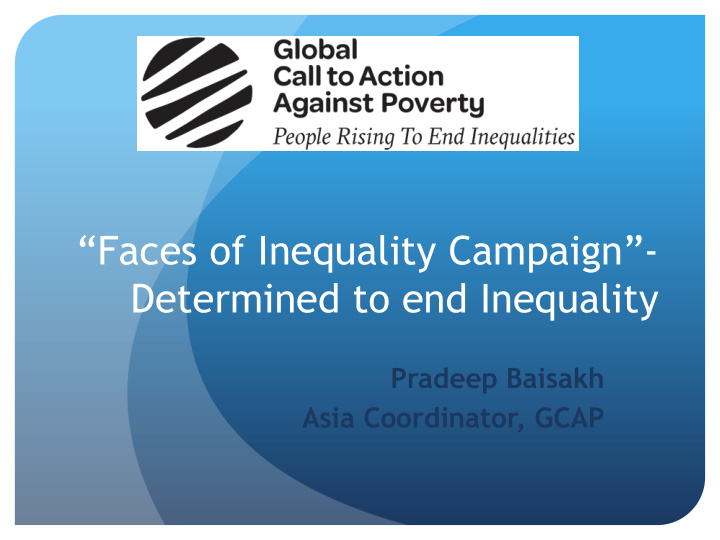



“Faces of Inequality Campaign” - Determined to end Inequality Pradeep Baisakh Asia Coordinator, GCAP
About GCAP Global Call to Action Against Poverty (GCAP) is a global campaign spread over 58 countries and works to address Inequality and Poverty Came to existence in 2004 to work on MDGs Strongly entrenched in the grassroots and works in a bottom up fashion South Asia presence: Afghanistan, Pakistan, India, Nepal, Sri Lanka, Bangladesh No presence in SW Asia
1a.Good Practices - #Act4SDGs mass mobilisation on Global Day of Action GCAP - UN SDG Action Campaign – APSD global mobilisation on the Global Day of Action (September 25) in 2017 Action4SD joined in 2018 Empowering people by ensuring that their voices are heard - power of campaigning To generate awareness, seek accountability and create impact A million people in 1227 cities and several rural areas in 142 countries did actions led by 1635 organisations/campaigns and individuals in 2018
Actions Rallies, Photo Stunts, Selfies, Sports and painting competitions, hand paintings, face paintings, Candle light march, cycle march Memorandum to the PMs and political leaders, interface with Planning Commissions/committees Public Meetings, workshops and consultations in Universities and town halls Social media: facebook, twitter, thunderclap with #Act4SDGs and #facesofinequality Marginalized communities: youth, women, children, persons with disability, Indigenous communities, Dalits etc and others participated My World Survey
Workshop In Nepal on 3 rd Anniversary
Unleashing Power of Aged People in Nepal
1200 meter long chain of banner on SDGs along coast in Sri Lanka
Rally in Pakistan
Children in India spreading awareness
Girls with Hand-Painting with SDGs in India
Leave No One Behind – India
Stand Up for SDGs Programme in front of Parliament in Bangladesh
1b. Good Practices - Regional APRCEM: Asia Pacific Regional Cooperation Engagement Mechanism Civil Society mechanism for engagement with the UN Systems Asia Civil Society Partnership for Sustainable Development (APSD) Independent CSO partnership to support CSOs at regional and national levels for capacity building, information sharing etc Supported CSO processes in Laos an Sri Lanka - engagement with VNR Asia Development Alliance (ADA) - capacity building on SDGs at regional, sub-regional level , engaging in CSO processes on VNR etc ADRF – Asia Dalit Rights Forum linking SDGs to identity based groups like Dalits and Indigenous communities
1c. Good Practices – National GCAP Pakistan (Pakistan Development Alliance) did a SDG gap analysis – Where Pakistan stand on SDGs 2018 Nepal SDGs forum (GCAP Nepal) working with 7 provincial government for awareness and implementation Wada Na Todo Abhiyan (India) and GCAP Nepal did a shadow report in 2017, Bangladesh CSOs did a civil society report Sri Lanka’s Voluntary People’s Report in 2018
2. Initiatives: Faces of Inequality Campaign – Inequality Reports and Videos Planning the Inequality Reports in Afghanistan, India, Nepal, Pakistan in South Asia Target is HLPF 2019 – influencing the global discourse on Inequality with more than 20 inequality reports globally Bring the “Faces” to the fore – Videos and stories Highlight discrimination, exclusion and inequality Consultations with the marginalized groups in each country – a bottom up approach
The most-vulnerable Groups Identity based exclusion: Indigenous communities and Dalits are discriminated at work, education, opportunities by descent Afghanistan: Religious minorities, women and children, ethnic minorities, old people, Socially excluded groups (Kuchi Nomads) etc Pakistan: Religious minorities, women and young people, LGBTQI etc Nepal: Madhesi, Dalits In Tarai region, Karnalik region (Geographical isolation) India: (100 hotspot study) Indigenous communities (Adivasis), Dalits, Persons with disabilities, sex workers , slum dwellers, children and youth Bangladesh: Indigenous, Rohingyas, Dalits, LGBTQI Sri Lanka: Plantation workers
3. Priorities for 2019 APFSD and HLPF Human Rights to be part of Inequality discourse in VNR Tax Justice (Issues of tax havens, NPAs, progressive tax etc) Access to essential services, especially for health and quality education Social protection – currently inadequate policy framework Decent work Gender justice: gender discrimination, violence etc Impacts of climate change on marginalised food security etc Financial inclusion and budget
Thank You pradeep.baisakh@whiteband.org
Recommend
More recommend